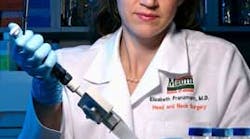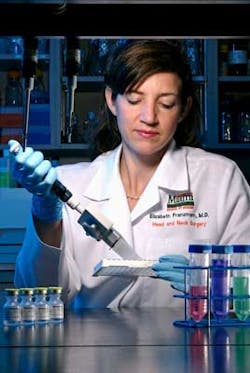What the 'rinse-and-spit' oral cancer test could mean for dental professionals and their patients
A new oral cancer “rinse-and-spit” test for the early detection of tumors could mean great things for dental professionals and their patients when the test becomes available for use in dental practices nationwide possibly as early as late 2014 or into 2015.
The test, developed at the University of Miami Miller School of Medicine and exclusively licensed to Vigilant Biosciences, Inc., will be available as a low-cost, point-of-care screening test for the early detection of oral cancer, and is envisioned as a kit with a special oral rinse and test strip. The test strip detects proteins that are markers of oral cancer and are captured by the rinse. The markers may be present before a lesion is easily visible. Early detection tests are critical because the majority of patients present in late stage when cure rates reach only 40%.
RELATED |A necessary challenge: How to talk to your patients about the connection between HPV and oral cancer
Principal investigator Elizabeth Franzmann, MD, associate professor of otolaryngology at the university and a member of the university’s Sylvester Comprehensive Cancer Center, conducted the study on 300 subjects. The National Cancer Institute was the sponsor. Read more about the study here.
I asked Dr. Franzmann to explain how the test strip works.
“The beauty of the test strip approach is that it is so simple for the patient and health-care professional to use. The technology behind the test strips has been around for many years and is used for many medical applications. The key is to know what to test for. Through our research, we discovered certain proteins, or markers, are present in the saliva in the early stages of squamous cell carcinoma, the most common head and neck cancer.”
How early can tumors be detected with the test strip?
Dr. Franzmann said, “The tumors can be detected in some instances before they become noticeable to the patient or the dentist. This is so important because today only about 40% of oral cancers are caught early enough to be cured.”
RELATED |Oral cancer is on the rise: Consumer Reports falls short
Does the cancer test strip distinguish among various types of tumors, or simply whether a tumor is cancerous or not?
Dr. Franzmann explained, “This test is for detecting squamous cell carcinoma, the most common head and neck cancer. The main risk factors for squamous cell carcinoma are tobacco and alcohol use and human papillomavirus infection.”
Once a test is performed, how long does it take for a patient to receive the results?
She continued, “This is a point-of-care test, meaning that the patient receives results in just a few minutes during the office visit.”
So, the big question is, when the product becomes available for dental offices, will it become part of the standard oral cancer screening process for patients?
Matthew H.J. Kim, JD, CEO of Vigilant Biosciences, said, “We believe that there is a tremendous unmet need for a test that not only detects cancer early when there is a better chance for a cure, but also rules out the disease. Current products generate many false positives that lead to unnecessary biopsies and cause undue stress on the patient and their family while they wait for results.”
Much has been in the news lately about the link between human papillomavirus and oral cancer. Dr. Franzmann weighed in: “HPV has been linked to oral cancer and cervical cancer. In both cases not all HPV infections lead to cancer. Other risk factors for oral cancer include smoking and alcohol use. Although our test is recommended for high-risk individuals including HPV infection, the number one cause of oral cancer, our test is designed to detect markers specific for oral cancer regardless of etiology.”
Vigilant’s new test product has the potential to play an enormous role in mass screening initiatives as it eventually becomes an integral part of routine oral cancer exams.
Mr. Kim firmly believes: “With health-care costs on the rise, it is important that new technology not only help find disease earlier when it costs less to treat but that it does a good job of ruling out disease to reduce unnecessary testing and patient anxiety.”








